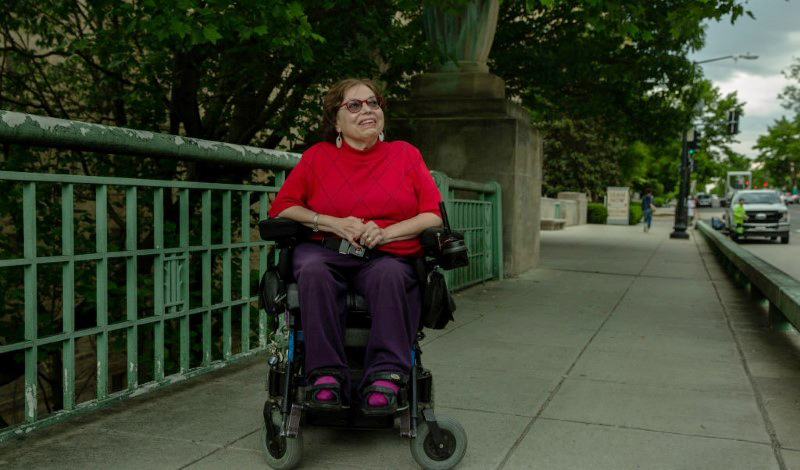
Judy Heumann’s fight for disability rights in the 1970s spawned an enduring, cross-disability movement.
Activist Judith Heumann is frequently called the mother of the disability rights movement. She refused to accept a world where disabled people could not live independent lives in their communities.
Tributes to Judy upon her death in March noted her many accomplishments. For example, after the New York City Board of Education refused to give her a teaching license, Judy became the first person to bring a disability rights case in federal court. She also played a vital role in developing and implementing many civil rights provisions that are still in effect today. And Judy was not only a force of nature in politics: She was also skilled at bringing people together and mentoring many disability advocates.
Judy played a pivotal role in forging new paths for disabled citizenship, particularly in her leadership of the Section 504 sit-ins of 1977.
Section 504 of the Rehabilitation Act of 1973 was the first civil rights law for people with disabilities. Its significance is frequently downplayed, but disability groups leveraged this law to create more accessible programs, workplaces, and transportation. The passage of regulations that implemented the law marked a turning point in the development of disabled citizenship, and the sit-ins Judy spearheaded were politically effective and cemented a sense of cross-disability solidarity.
In her book, Being Heumann: An Unrepentant Memoir of a Disability Rights Activist, Judy chronicled the history of the Section 504 implementing regulations. Nearly five years and multiple presidential administrations after passage of Section 504, the U.S. Department of Housing, Education, and Welfare (HEW) refused to issue implementing regulations. Activists forced the government’s hand by occupying HEW offices across the country.
Judy and fellow disability rights activist Kitty Cone organized what appeared to be a normal protest but what was in fact an orchestrated prelude to entering and occupying HEW offices in San Francisco. The occupation began when Judy yelled to protesters, “Let’s go and tell HEW the federal government cannot steal our civil rights!”
Judy remembered HEW employees treating protestors like people on a field trip, handing out cookies and punch. The employees, however, “under-catered” as Judy quipped. More than 100 people occupied HEW’s San Francisco office for 26 days.
Many participants risked their lives: Their medical attendants were barred from entering the building, and many did not have back-up medical devices in case theirs failed.
Those who stayed built community. Some protestors found love (and sex—it was the 1970s after all). Others developed a sense of belonging. People found the atmosphere empowering. As activist HolLynn D’Lil claimed, “we created a new citizen for this country. We created us: We People with Disabilities.”
The community rallied in support, while the government retaliated. Local churches held vigils. The governor of California wrote to President Jimmy Carter. The Black Panthers broke into the blockaded building to provide food for all 125 protestors daily. The government blocked outgoing calls, so messages to the outside world were relayed by walkie-talkies provided by local queer organizations, as well as by Deaf protestors via sign language. When government officials fabricated a bomb threat to evacuate the building, the protestors stayed.
Members of Congress organized a hearing inside the occupied building. HEW sent a low-level bureaucrat to the meeting who argued that the regulations should enshrine “separate but equal” protections for people with disabilities.
At the hearing, Judy confronted the bureaucrat, and many others discussed their personal experiences of social exclusion. The testimony was formidable and lasted five hours. In fact, at one point, the overwhelmed HEW bureaucrat ran and locked himself in a room down the hall. Representative Phillip Burton (D-Calif.) forced him to return to the hearing.
The congressional hearing, however, could not persuade HEW’s Secretary Joseph Califano to even meet with the protestors. As a result, Judy and a cohort of protestors brought the fight to Washington, D.C., where they held vigils for multiple nights outside of Califano’s house and visited President Carter at church. Both Califano and President Carter escaped through back doors to avoid the protestors.
Then, on April 28, 24 days into the sit-in, Califano signed the regulations. Protestors left HEW’s San Francisco office on April 30 victorious.
In my own research, I argue that the Section 504 sit-ins constituted what Engin Isin and Greg M. Nielsen call “acts of citizenship.” Acts of citizenship are moments where people rupture the status quo. They are moments where people change paradigms, establish rights, and create new political possibilities.
The Section 504 sit-ins were a moment where disabled people defined citizenship for themselves, as opposed to allowing governing institutions to define it for them. Participants developed solidarity, practiced mutual assistance and active listening, and built a self-governing community. Some say people who were involved “never completely left the building.” And that was in large part due to the tenacious organizing strategies of Judy Heumann, Kitty Cone, and others.
Section 504 created a formal means of asserting rights. Disabled Americans used their hard-won Section 504 rights to carve out employment rights, to develop trainings about how disabled people could use Section 504 to negotiate with their employers, and to hold federally funded programs accountable to accessibility standards.
The Section 504 sit-ins also gave participants the confidence to assert their rights. Those participants who reported never really leaving the building were left with a sense of themselves as citizens entitled to equal rights.
The legacy of the Section 504 sit-ins endures. Disabled Americans are acutely aware of the government’s influence over their income, health care, ability to live independent lives, civil rights, and more. And they also regularly assert their rights in administrative contexts where they are often neglected. For example, when Rochelle Walensky, the Director of the Centers for Disease Control and Prevention, called it “encouraging” that only people with comorbidities were dying of COVID-19, the disability community came out in full force and demanded an apology.
Judy’s most enduring legacy is the community that she helped build and the opportunities that her organizing opened. By creating spaces by and for disabled people through the Section 504 sit-ins, she carved out new possibilities for disabled citizenship going forward.
Although current events make political problems seem intractable, we can all learn from Judy: simply refuse to accept the world as it is and make a fuss about it.




